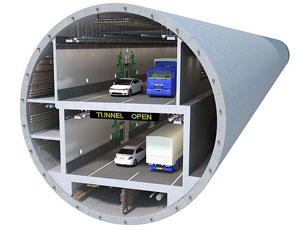A joint venture led by Dragados USA, New York City, and Tutor Perini Corp., Sylmar, Calif., is now able to begin revising its best-value winning bid to build a 1.7-mile, 55-ft-diameter deep bore tunnel beneath downtown Seattle. Tunnel Partners, which also includes Frank Coluccio Construction Co., Tukwila, Wash.; Mowat Construction Co., Kent, Wash.; HNTB Corp., Kansas City; and Spanish firm Intecsa, Madrid, submitted the favored best value proposal with a $1.09 billion bid plus technical credits that totaled 71,577,000, for a resulting best value score of 1,018,123,002, the Washington State Dept. of Transportation announced Dec. 9.

A Supplemental Draft Environmental Impact Statement (EIS) that analyzes the bored tunnel alternative was closed to public comment Dec. 13. The team can now begin tweaking its bid in response to the comments.
There were up to 100 million technical credits, in the form of dollars, that could be earned by each team in the areas of overall management, schedule, tunnel roadway clearances, management of tunneling and ground deformation, and design and construction other than tunneling. The Seattle Tunneling Group, the only other joint venture vying for the contract, submitted a bid price of $1.088 billion with technical credits of 38,152,000, resulting in a slightly lower apparent best-value score of 1,050,150,002. Its joint venture is comprised of S.A. Healy Co., Lombard, Ill.; FCC Construccion S.A. of Spain; Parsons Transportation Group, Pasadena, Calif.; and Halcrow Inc., New York City.
“Seattle Tunnel Partners won technical credits for proposing a slightly wider tunnel boring machine that would allow the shoulders inside the tunnel to be 8 ft rather than the 6 ft required in the Request for Proposals,” says Ron Paananen, WSDOT project manager. It also devised a simpler southern tunnel approach that narrows the footprint significantly, and promised to complete the project one year ahead of schedule. Paananen would not discuss further details of the proposal until the contract is awarded in January.
The contract maximum price was $1.09 billion. The state expects to award the contract later this month and issue a notice to proceed in early January. The project calls for construction of approximately 12,500 linear ft of new roadway, of which 9,273 will be constructed using an earth-pressure-balance boring machine.
Major items contained in the design-build request for proposals included acquisition of a tunnel boring machine (TBM); boring the tunnel; and building the road within the tunnel with ventilation, and emergency and electrical systems. The contract will also cover construction of two operations buildings, mitigation for tunnel settlement and construction of tunnel portals. Most of the work will be performed as a lump-sum, fixed-price bid.
Both teams received a $4 million stipend for preparing proposals. Originally two other teams prequalified, but dropped out, stating concerns over the amount of risk placed on the contractor. In the past, mining in Seattle’s glacial till has resulted in TBMs being permanently incapacitated.
Total cost of the proposed bored tunnel is estimated to be $1.96 billion. This includes design, right-of-way acquisition, construction management, and more than $200 million set aside for risk. It also provides for separate, future construction contracts for roadway connections at the north and south ends of the tunnel.
Actual construction work could start in August 2011. Paananen would not comment on whether the draft EIS would cause any design changes. “We don’t foresee anything unusual ... but we know there is a chance we could be sued once a record of decision is filed,” Paananen says. Several community activist groups have vowed to stop the tunnel construction, stating it is too expensive and that there are better alternatives.
A 2007 report found that there is a one-in-ten chance that an earthquake will cause part of the viaduct to collapse within the next ten years. Until the tunnel is completed, WDOT will monitor it for shifting or other structural problems. It is now completing a $5.5 million project that would close the roadway in case of an earthquake.

Post a comment to this article
Report Abusive Comment